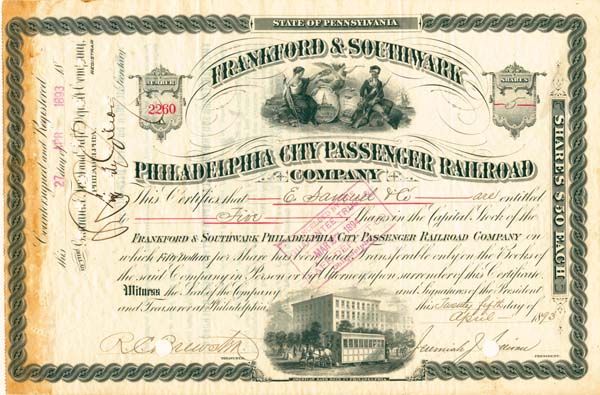Frankford and Southwark Philadelphia City Passenger Railroad - Stock Certificate
Inv# RS2804 Stock
Stock printed by American Bank Note Co., Phila.
Philadelphia, colloquially Philly, is a city in the state of Pennsylvania in the United States. It is the sixth-most-populous city in the United States and the most populous city in the state of Pennsylvania, with a 2019 estimated population of 1,584,064. It is also the second-most populous city in the Northeastern United States, behind New York City. Since 1854, the city has had the same geographic boundaries as Philadelphia County, the most-populous county in Pennsylvania and the urban core of the eighth-largest U.S. metropolitan statistical area, with over 6 million residents as of 2017. Philadelphia is also the economic and cultural center of the greater Delaware Valley along the lower Delaware and Schuylkill rivers within the Northeast megalopolis. The Delaware Valley's 2019 estimated population of 7.21 million makes it the ninth-largest combined statistical area in the United States.
Philadelphia is one of the oldest municipalities in the United States. William Penn, an English Quaker, founded the city in 1682 to serve as capital of the Pennsylvania Colony. Philadelphia played an instrumental role in the American Revolution as a meeting place for the Founding Fathers of the United States, who signed the Declaration of Independence in 1776 at the Second Continental Congress, and the Constitution at the Philadelphia Convention of 1787. Several other key events occurred in Philadelphia during the Revolutionary War including the First Continental Congress, the preservation of the Liberty Bell, the Battle of Germantown, and the Siege of Fort Mifflin. Philadelphia remained the nation's largest city until being overtaken by New York City in 1790; the city was also one of the nation's capitals during the revolution, serving as temporary U.S. capital while Washington, D.C. was under construction. In the 19th and 20th centuries, Philadelphia became a major industrial center and a railroad hub. The city grew due to an influx of European immigrants, most of whom initially came from Ireland and Germany—the two largest reported ancestry groups in the city as of 2015. Later immigrant groups in the 20th century came from Italy (Italian being the third largest European ethnic ancestry currently reported in Philadelphia) and other Southern European and Eastern European countries. In the early 20th century, Philadelphia became a prime destination for African Americans during the Great Migration after the Civil War. Puerto Ricans began moving to the city in large numbers in the period between World War I and II, and in even greater numbers in the post-war period. The city's population doubled from one million to two million people between 1890 and 1950.
The Philadelphia area's many universities and colleges make it a top study destination, as the city has evolved into an educational and economic hub. As of 2019, the Philadelphia metropolitan area is estimated to produce a gross metropolitan product (GMP) of $490 billion. Philadelphia is the center of economic activity in Pennsylvania and is home to five Fortune 1000 companies. The Philadelphia skyline is expanding, with a market of almost 81,900 commercial properties in 2016, including several nationally prominent skyscrapers. Philadelphia has more outdoor sculptures and murals than any other American city. Fairmount Park, when combined with the adjacent Wissahickon Valley Park in the same watershed, is one of the largest contiguous urban park areas in the United States. The city is known for its arts, culture, cuisine, and colonial history, attracting 42 million domestic tourists in 2016 who spent $6.8 billion, generating an estimated $11 billion in total economic impact in the city and surrounding four counties of Pennsylvania. Philadelphia has also emerged as a biotechnology hub.
Philadelphia is the home of many U.S. firsts, including the first library (1731), hospital (1751), medical school (1765), national capital (1774), stock exchange (1790), zoo (1874), and business school (1881). Philadelphia contains 67 National Historic Landmarks and the World Heritage Site of Independence Hall. The city became a member of the Organization of World Heritage Cities in 2015, as the first World Heritage City in the United States.
A stock certificate is issued by businesses, usually companies. A stock is part of the permanent finance of a business. Normally, they are never repaid, and the investor can recover his/her money only by selling to another investor. Most stocks, or also called shares, earn dividends, at the business's discretion, depending on how well it has traded. A stockholder or shareholder is a part-owner of the business that issued the stock certificates.










Ebay ID: labarre_galleries